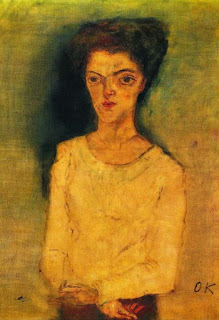(Click on images to enlarge)
(Moore, Charles, Official Catalog of Exhibitors, Panama-Pacific International Exposition, San Francisco, California, 1915.
The above catalog lists the titles of the 16 portraits by Oskar Kokoschka that Adolf Loos was credited for lending to the Panama-Pacific International Exposition's Department of Fine Arts Exhibition held in Bernard Maybeck's Palace of Fine Arts (see below) throughout 1915. From this I was able to reconstruct what was Kokoschka's first exhibited work in the United States. Loos was very close friends with Kokoschka and provided him much patronage by commissioning portraits and soliciting friends to do the same. He also did all he could to promote the troubled artist's career. I am beginning to learn how this amazing loan came about and would appreciate any further insight on this.
Palace of Fine Arts, Panama Pacific International Exposition, 1915. Bernard Maybeck, architect. Photo by R. M. Schindler, fall 1915. Courtesy UC Santa Barbara Art Museum, Architecture and Design Collections, Schindler Collection.
Palace of Fine Arts Exhibition Floor Plan, Moore, Charles, Official Catalog of Exhibitors, Panama-Pacific International Exposition, San Francisco, California, 1915.
Kokoschka's work was hung in the International Section which was assigned to Galleries 108, 121 and 143 (see floor plan above). Much of the International Section was arranged by Mr. J. Nilsen Laurvik, Special Representative of the Department of Fine Arts. He made a an exhaustive European scouting trip and rounded up hundreds of art works on behalf of the Exposition. Laurvik had two years earlier published a fascinating critique of the infamous Armory Show in New York (see below) which positioned himself to head up the search for like-minded work for the Exposition's massive Palace of Fine Arts exhibition. (I am trying to learn where and when he might have met Loos and Kokoschka and would appreciate any leads).
Is It Art? Post-Impressionism, Futurism, Cubism by J. Nilsen Laurvik, International Press, New York, 1913.
No. 307, "Architect Adolf Loos," 1909.
No. 308, "Dr. Egon Wellez," 1911.
No. 309, "Peter Altenberg," 1909.
No. 310, "Portrait of the Artist," (Self-portrait), 1913.
No. 311, "Emma Veronica Sanders" (aka "Doctor Emma Veronika Sanders"), 1909.
No. 312, "Dr. Von Webern, Composer," 1914.
No. 313, "Angora Cat," date unknown.
No. 314, Paul Scheerbaut, 1910.
No. 315, "Dr. Verona" (aka "Conte Verona"), 1910.
No. 316, "Dr. de Jankosky" (aka "Ludwing Ritter von Janikowsky"), 1909.
No. 317, "Mrs. H" (aka "Martha Hirsch" and "Dreaming Woman"), 1909.
No. 318, "Mrs. Adolf Loos" (Bessie Bruce), 1910.
No. 319, "Two Children" (aka "Children Playing"), 1909.
No. 320, "Italian Lady" (aka "Lady in Red"?), 1910.
No. 321, "Child in the Hands of Father and Mother," (aka "Child in the Hands of its Parents"), 1909.
No. 621, "Karl Kraus," 1909.
This was indeed a wonderful exhibition of Kokoschka's work made possible by the patronage of Adolf Loos and Laurvik's relentless scouting efforts. I hope the upcoming exhibition "Jewel City: Art from San Francisco’s Panama-PacificInternational Exposition" at the de Young Museum this fall will includes some of the above paintings. I intend to do some further research to learn how the sitters of the above portraits fit into the lives of Kokoschka, Loos and their circles in 1910s Vienna. I would also love to find some Schindler and Neutra connections as they came into Loos's orbit during this period. One that seems certain is the Kokoschka lithograph of Karl Kraus that was done in 1901 and appeared in Der Sturm in 1910 (see below). Kraus was a great inspiration for Schindler after his introduction by Loos ca. 1910. Stay tuned for the backstory.
Karl Kraus lithograph by Oskar Kokaschka, ca. 1901.
See also my companion piece from yesterday "Adolf Loos, Oskar Kokoschka and the Panama-Pacific International Exposition" in which I reference Schindler's reverence for Karl Kraus (see above). (For much more on the Schindlers and Kraus see my "Pauline
Gibling Schindler, Taliesin, to Eugene Debs, Atlanta Federal Penitentiary,
August 22, 1920").




















